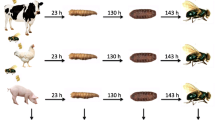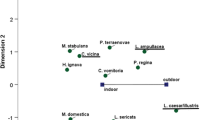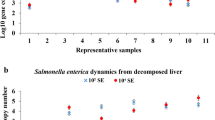Abstract
Blow flies are important tools in forensic entomology, as they feed and develop on human bodies. This fact can be used to estimate the minimum post mortem interval (PMImin), by classifying the age of the immature stages found on corpses. The capacity to also be able to classify the age of adult flies, or even empty puparia, could increase the timeframe for a PMImin. However, the association of older developmental stages, such as adult flies or their empty cases, with a human cadaver may be challenged, as such specimens could stem from another food source. Analyzing the stable carbon (δ13C) and nitrogen (δ15N) isotopes in such specimens could be helpful here, as the isotope signatures reflect those of the food sources. We compared the δ15N and δ13C signatures of tissue from humans and 12 additional species by elemental analyzer-isotope ratio mass spectrometry (EA-IRMS). We did the same for adult flies and empty puparia of the blow fly Lucilia sericata, which were derived from juvenile stages developed on tissues from the mentioned species. The isotope signatures for the adult flies and their empty puparia linearly mirrored the isotope signatures for the respective tissues on which they developed as larvae. Results such as these are useful to indicate the flies’ nutritional history, but they do not provide the same kind of evidence that a DNA analysis would. As individual dietary habits, global distribution and environmental effects can influence isotope ratios, we strongly recommend to analyzing entomological traces and muscle tissues of potential donors or for other food sources.


Similar content being viewed by others
References
Sanford MR (2015) Forensic entomology of decomposing humans and their decomposing pets. Forensic Sci Int 247:e11–e17. https://doi.org/10.1016/j.forsciint.2014.11.029
Amendt J, Richards CS, Campobasso CP, Zehner R, Hall MJR (2011) Forensic entomology: applications and limitations. Forensic Sci Med Pathol 7(4):379–392. https://doi.org/10.1007/s12024-010-9209-2
Catts EP (1992) Problems in estimating the postmortem interval. J Agric Entomol 9:245–255
Matuszewski S, Bajerlein D, Konwerski S, Szpila K (2008) An initial study of insect succession and carrion decomposition in various forest habitats of Central Europe. Forensic Sci Int 180(2-3):61–69. https://doi.org/10.1016/j.forsciint.2008.06.015
Payne JA (1965) A summer carrion study of the baby pig Sus scrofa Linnaeus. Ecology 46(5):592–602. https://doi.org/10.2307/1934999
Amendt J, Campobasso CP, Gaudry E, Reiter C, LeBlanc HN, Hall MJ, European Association for Forensic Entomology (2007) Best practice in forensic entomology—standards and guidelines. Int J Legal Med 121(2):90–104. https://doi.org/10.1007/s00414-006-0086-x
Pechal JL, Moore H, Drijfhout F, Benbow ME (2014) Hydrocarbon profiles throughout adult Calliphoridae aging: a promising tool for forensic entomology. Forensic Sci Int 245:65–71. https://doi.org/10.1016/j.forsciint.2014.10.019
Bernhardt V, Hannig L, Kinast R, Verhoff MA, Rothweiler F, Zehner R, Amendt J (2017) Quantitative pteridine fluorescence analysis: a possible age-grading technique for the adult stages of the blow fly Calliphora vicina (Diptera: Calliphoridae). J Insect Physiol 98:356–359. https://doi.org/10.1016/j.jinsphys.2017.03.002
Zhu GH, Ye GY, Li K et al (2013) Determining the age of adult flesh flies, Boettcherisca peregrina, using pteridine fluorescence. Med Vet Entomol 27(1):59–63. https://doi.org/10.1111/j.1365-2915.2012.01021.x
Zhu GH, Jia ZJ, XJ Y et al (2017) Predictable weathering of puparial hydrocarbons of necrophagous flies for determining the postmortem interval: a field experiment using Chrysomya rufifacies. Int J Legal Med 131(3):885–894. https://doi.org/10.1007/s00414-016-1507-0
Zhu GH, XJ Y, Xie LX et al (2013) Time of death revealed by hydrocarbons of empty puparia of Chrysomya megacephala (Fabricius) (Diptera: Calliphoridae): a field experiment. PLoS One 8(9):e73043. https://doi.org/10.1371/journal.pone.0073043
Zhu GH, XH X, XJ Y et al (2007) Puparial case hydrocarbons of Chrysomya megacephala as an indicator of the postmortem interval. Forensic Sci Int 169(1):1–5. https://doi.org/10.1016/j.forsciint.2006.06.078
Bernhardt V, Pogoda W, Verhoff MA, Toennes SW, Amendt J (2017) Estimating the age of the adult stages of the blow flies Lucilia sericata and Calliphora vicina (Diptera: Calliphoridae) by means of the cuticular hydrocarbon n-pentacosane. Sci Justice 57(5):361–365. https://doi.org/10.1016/j.scijus.2017.04.007
Archer MS, Elgar MA, Briggs CA, Ranson DL (2006) Fly pupae and puparia as potential contaminants of forensic entomology samples from sites of body discovery. Int J Legal Med 120(6):364–368. https://doi.org/10.1007/s00414-005-0046-x
Marchetti D, Arena E, Boschi I, Vanin S (2013) Human DNA extraction from empty puparia. Forensic Sci Int 229(1-3):e26–e29. https://doi.org/10.1016/j.forsciint.2013.03.043
Schoeninger MJ, DeNiro MJ (1984) Nitrogen and carbon isotopic composition of bone collagen from marine and terrestrial animals. Geochim Cosmochim Acta 48(4):625–639. https://doi.org/10.1016/0016-7037(84)90091-7
Schoeninger MJ (1995) Stable isotope studies in human evolution. Evol Anthropol Issues News Rev 4:83–98
O’Leary MH (1981) Carbon isotope fractionation in plants. Phytochemistry 20(4):553–567. https://doi.org/10.1016/0031-9422(81)85134-5
Eggers T, Jones TH (2000) You are what you eat...or are you? Trends Ecol Evol 15(7):265–266. https://doi.org/10.1016/S0169-5347(00)01877-2
Huelsemann F, Lehn C, Schneider S et al (2015) Global spatial distributions of nitrogen and carbon stable isotope ratios of modern human hair. Rapid Commun Mass Spectrom 29(22):2111–2121. https://doi.org/10.1002/rcm.7370
Bol R, Pflieger C (2002) Stable isotope (13C, 15N and 34S) analysis of the hair of modern humans and their domestic animals. Rapid Commun Mass Spectrom 16(23):2195–2200. https://doi.org/10.1002/rcm.706
Schoeninger MJ (2014) Stable isotope analyses and the evolution of human diets. Annu Rev Anthropol 43(1):413–430. https://doi.org/10.1146/annurev-anthro-102313-025935
Boecklen WJ, Yarnes CT, Cook BA, James AC (2011) On the use of stable isotopes in trophic ecology. Annu Rev Ecol Evol Syst 42(1):411–440. https://doi.org/10.1146/annurev-ecolsys-102209-144726
Meier-Augenstein W (2010) Stable isotope forensics—an introduction to the forensic application of stable isotope analysis/Wolfram Meier-Augenstein. Wiley Blackwell
Petzke KJ, Boeing H, Metges CC (2005) Choice of dietary protein of vegetarians and omnivores is reflected in their hair protein 13C and 15N abundance. Rapid Commun Mass Spectrom 19(11):1392–1400. https://doi.org/10.1002/rcm.1925
Fraser RA, Bogaard A, Schäfer M, Arbogast R, Heaton THE (2013) Integrating botanical, faunal and human stable carbon and nitrogen isotope values to reconstruct land use and palaeodiet at LBK Vaihingen an der Enz, Baden-Württemberg. World Archaeol 45(3):492–517. https://doi.org/10.1080/00438243.2013.820649
Tieszen LL, Boutton TW, Tesdahl KG, Slade NA (1983) Fractionation and turnover of stable carbon isotopes in animal tissues: implications for δ13C analysis of diet. Oecologia 57(1-2):32–37. https://doi.org/10.1007/BF00379558
Markow TA, Anwar S, Pfeiler E (2000) Stable isotope ratios of carbon and nitrogen in natural populations of Drosophila species and their hosts. Funct Ecol 14(2):261–266. https://doi.org/10.1046/j.1365-2435.2000.00408.x
Heinrich K, Weaver RJ, Bell HA (2012) Determining the source of house flies (Musca domestica) using stable isotope analysis. Pest Manag Sci 68(1):31–37. https://doi.org/10.1002/ps.2215
McCutchan JH, Lewis WM, Kendall C, McGrath CC (2003) Variation in trophic shift for stable isotope ratios of carbon, nitrogen, and sulfur. Oikos 102(2):378–390. https://doi.org/10.1034/j.1600-0706.2003.12098.x
Peterson BJ, Fry B (1987) Stable isotopes in ecosystem studies. Annu Rev Ecol Syst 18(1):293–320. https://doi.org/10.1146/annurev.es.18.110187.001453
DeNiro MJ, Epstein S (1981) Influence of diet on the distribution of nitrogen isotopes in animals. Geochim Cosmochim Acta 45(3):341–351. https://doi.org/10.1016/0016-7037(81)90244-1
Minagawa M, Wada E (1984) Stepwise enrichment of 15N along food chains: further evidence and the relation between δ15N and animal age. Geochim Cosmochim Acta 48(5):1135–1140. https://doi.org/10.1016/0016-7037(84)90204-7
Webb SC, Hedges RE, Simpson SJ (1998) Diet quality influences the δ13C and δ15N of locusts and their biochemical components. J Exp Biol 201(Pt 20):2903–2911
Jobling MA, Gill P (2004) Encoded evidence: DNA in forensic analysis. Nat Rev Genet 5(10):739–751. https://doi.org/10.1038/nrg1455
Lehn C, Graw M (2014) Stabilisotopenanalysen an Körpergeweben von unbekannten Personen: Grundlagen, Probennahme, Analysen, Interpretation. Rechtsmedizin 24(2):129–143. https://doi.org/10.1007/s00194-014-0946-5
Ben-David M, Flaherty EA (2012) Stable isotopes in mammalian research: a beginner’s guide. J Mammal 93(2):312–328. https://doi.org/10.1644/11-MAMM-S-166.1
Rubenstein DR, Hobson KA (2004) From birds to butterflies: animal movement patterns and stable isotopes. Trends Ecol Evol 19(5):256–263. https://doi.org/10.1016/j.tree.2004.03.017
Fry B (2006) Stable isotope ecology. Springer, New York. https://doi.org/10.1007/0-387-33745-8
Acknowledgments
We thank Dr. Christoph Schomerus (Dr. Senkenbergische Anatomy, University Hospital Frankfurt, Germany), Dr. Kernt Köhler (Institute of Veterinary Pathology, Gießen, Germany), and Dr. Christa Tandi (Central research facility, University hospital Frankfurt, Germany) for providing tissue donations/samples. We would also like to thank both anonymous reviewers who substantially improved the manuscript with their comments and corrections.
Author information
Authors and Affiliations
Corresponding author
Ethics declarations
Conflict of interest
The authors declare that they have no conflict of interest.
Ethical approval
All procedures performed in studies involving human participants were in accordance with the ethical standards of the institutional and/or national research committee and with the 1964 Helsinki declaration and its later amendments or comparable ethical standards. All applicable international, national, and/or institutional guidelines for the care and use of animals were followed.
Rights and permissions
About this article
Cite this article
Bernhardt, V., Holdermann, T., Scheid, N. et al. Same, same but different!—matching entomological traces to a human food source by stable isotope analysis. Int J Legal Med 132, 915–921 (2018). https://doi.org/10.1007/s00414-017-1753-9
Received:
Accepted:
Published:
Issue Date:
DOI: https://doi.org/10.1007/s00414-017-1753-9




